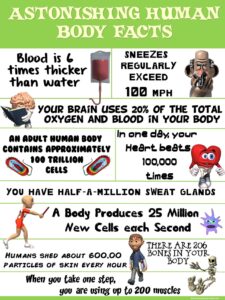The superlatives in our bodies are endless. Each of us has 5 million hair follicles, about 100,000 of them on the head: with some people having more than others. Blondes have about 150,000; those with black or brown hair about 100,000, and redheads or those with auburn hair about 90,000. Hair can continue to grow on one part of the body while another part of the same body remains hairless. A bald man with a smooth dome can still have a fully grown beard. The same blood that carries nutrients and all sorts of chemicals including hormones flows to both areas, yet one area is totally devoid of hair while the other area is hair-dense. Doctors and scientists explain that the hair follicles in the scalp of the bald man are no longer sensitive to those chemicals, and therefore do not respond to them to cause hair growth, but what causes that insensitivity?
There are 270 bones in the body at birth, and 206 in adults; some of the bones join with their neighbours to become one during growth and development. There are 550 skeletal muscles, including 320 pairs of muscles. The number varies between 640 and 850 depending on how the count is made; some people count pairs of muscles as two, and others include muscles not usually counted, e.g. the tongue.
Our intestines are 23 feet or 7 metres long, consisting of the small intestine at 18 feet (5.5 metres) and the large intestine at 5 feet or 1.5 metres. These are arranged by being wound round and round like a string coiled up on itself, so they can be accommodated in our relatively small bellies.
There are about 7 million eggs or ova in the female baby while it is still in its mother’s womb. This reduces to about 700,000 by the time the child becomes an adult. Twelve of these start maturing through each monthly menstrual cycle, but only one of them completes this maturation process enough to be released at ovulation at the middle of the cycle. When two ova mature instead of one, and both are fertilised, we have fraternal or non-identical twins; likewise, very rarely three ova will mature to give rise to triplets. Fertility treatment may induce more ova maturation. This maturation process starts very early – about 150 days before the actual ovulation for each set of ova, after which the ova can live for 12-24 hours or so.
 The male equivalent, the sperm, (short for spermatozoa), are much, much greater in number. The normal adult sperm count varies from 40 to 300 million per ml, and a man can have up to 5 ml of ejaculate each time and can do this through 40 or more reproductive years. Counts of less than 10 million/per ml may have difficulty causing a pregnancy, but it’s not all just about numbers. Sperm structure and motility – ability to move – are also important, as are factors in the female body. Hence investigations of possible infertility must take the couple together as a unit. It has been calculated that 1500 sperms are produced per second in a normal healthy male; that is 1500 x 60 x 60 X 24, or nearly 13 million per day. Still counting? Do the math for a whole lifetime!
The male equivalent, the sperm, (short for spermatozoa), are much, much greater in number. The normal adult sperm count varies from 40 to 300 million per ml, and a man can have up to 5 ml of ejaculate each time and can do this through 40 or more reproductive years. Counts of less than 10 million/per ml may have difficulty causing a pregnancy, but it’s not all just about numbers. Sperm structure and motility – ability to move – are also important, as are factors in the female body. Hence investigations of possible infertility must take the couple together as a unit. It has been calculated that 1500 sperms are produced per second in a normal healthy male; that is 1500 x 60 x 60 X 24, or nearly 13 million per day. Still counting? Do the math for a whole lifetime!
The sperm live for up to five days in the female body, and of all the millions released, only one of them is needed for fertilisation, and only one of them makes it! They each bear distinct sex chromosomes responsible for the eventual gender of the conceived baby: X for the female and Y for the male. Since women have the X chromosomes, the ova are all X bearing, hence the gender of the child depends on the father. Fertilisation by the X sperm makes the conceived child XX (female) while fertilisation by the Y sperm makes the child XY (male). In some countries, especially those where the male offspring is particularly desired, the wife is often blamed for having children of only one gender, usually female, but she brings forth only what the man gives her. So, he is responsible!
Have you ever wondered what keeps the baby in its mother’s womb until its nine months period of growth and development are completed? The womb has to be tightly closed during this time, or the woman may miscarry and lose the child. When nine months are completed, then the previously tightly closed neck of the womb (cervix) is opened, and the baby comes forth. What triggers this change? We still don’t know.
The most astounding thing about all these numbers, and many more that are not dealt with in this series of articles, is that all these cells, different in structure and function, and so numerous as to be virtually uncountable, all started from the union of two cells, the ova and the sperm, both invisible to the naked eye.
We are truly uniquely and wonderfully made!


